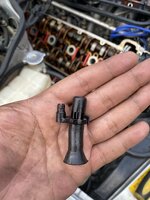I lifted up the car today to inspect a leak from the back corner passenger side of the transmission pan.
Found this component real wet, is it possible to leak from here? This is a generic pic I don’t know what this is!
While looking I saw a pretty massive leak from the back side of the passenger side valve cover gasket from what it looks like. Can this leak on the passenger side be all related to valve cover gasket? Please see below



Found this component real wet, is it possible to leak from here? This is a generic pic I don’t know what this is!

While looking I saw a pretty massive leak from the back side of the passenger side valve cover gasket from what it looks like. Can this leak on the passenger side be all related to valve cover gasket? Please see below








